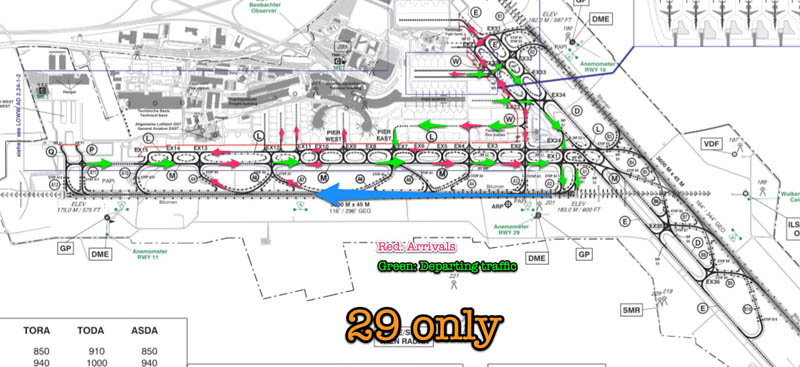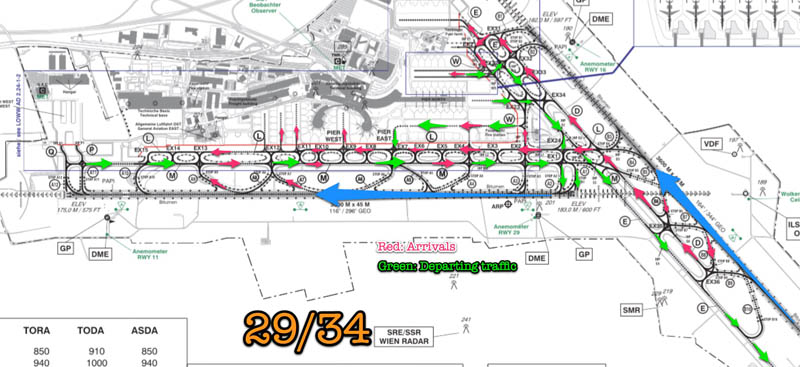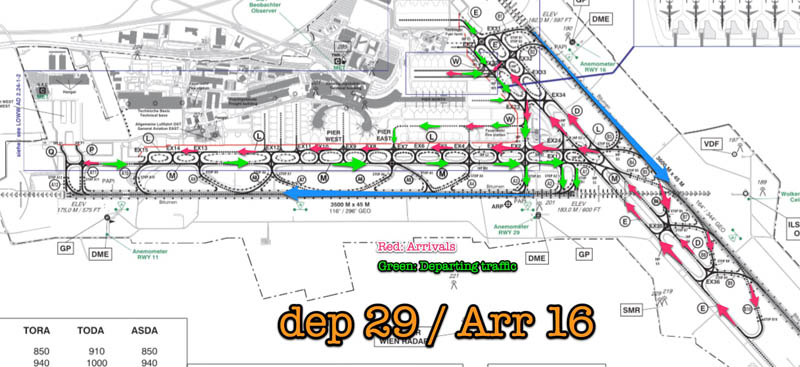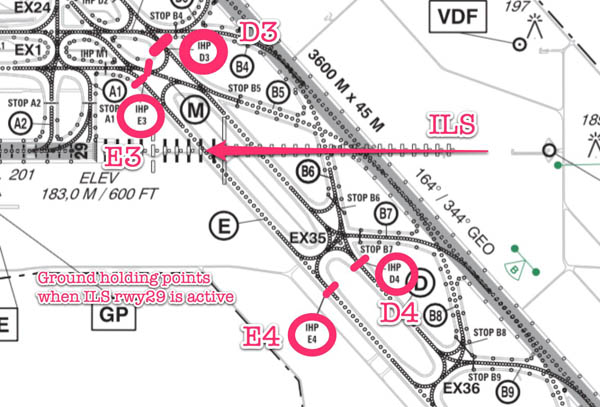LOWW Primer
About this Document
This document is intended as training and reference material for controlling Vienna Airport (LOWW). This page is work in progress. If you are controller: Feel free to discuss and edit.
If you are a Pilot: The page Vienna is a better source for you, with more info on flying airplanes and less on controlling.
AIRAC status is 1704 (May 2017).
The structure of this document follows the stations to be manned: DEL, GND, TWR, APP.
Overview
Vienna has two runways, which flight paths cross. Still, the airport has frequencies which make parallel operations necessary - therefore, Vienna has developed a set of special rules and practices on how to use them.
Ground
(see the ground chart [which you find here]).
Vienna has three piers with gates and some stands around. From West to East, there are:
- General Aviation West is all the way to the West at Taxiways Q and P.
- Some stands at the maintainance area (A91 to A99)
- General Aviation East is near EX13.
- Two rarely used stands (B52 and B62) are next
- Near EX12, there are three rows for small commercial airliners B71 to B92).
- Pier West (gates C31 to C42) and Pier East (D21 to D29) are next. They all match M aircraft, with the corner stands C36, C39, D23, D26 and D28) for H aircraft too.
- Pier North or "Skylink" is relatively new (and most likely the most expensive pier after BER airport *irony*), providing gates to the South (F01-F37, odd numbers) and the North F04-F36, even numbers).
Besides to the East, there are stands for large aircraft - currently the only places for the A380.
- South of Pier North are stands for smaller and budget airliners (the E stands).
- North of Pier North is another row for the same (the H stands).
Taxiways
- Two parallel taxiways (L and M) run along runway 11/29. Caution: Taxiway L after EX12 is narrower and cannot be used for M and H aircraft.
- Runway 16/34 have another two taxiways: D and E. D is somehow shorter, E goes through all the way.
- An extra taxiway (W) leads from EX2 to EX21.
- Then there are some taxilanes to access Pier North (TL35, 36 and 37 to the South of the pier, TL40 to the North). TL40 has a blue (south) and an orange (north) variant, which not all sceneries have, so be aware if pilots can see it.
DEL - Delivery position
Delivery in Wien is straightforward as described in the Study_Guide:Delivery. Bear in mind the following factors:
- There is a Noise Abatement procedure after 21:00 local time, which changes runways to 29-only, if wind permits. SIDs after 21:00 might change. Tower changes runways, so expect to be notified of the change.
- VFR traffic does not necessary depart or land from the runway in use - enquire from TWR, what to clear, and if TWR or DEL clears. Most likely you will clear him (set the runway in Euroscope) and hand him over to ground as any other IFR flight. Enter the exit route into the flight plan or the text field in the tag.
GND - Ground Position
Ground position in Vienna is somehow complicated. Why? Because traffic flow changes with runway configuration, and sometimes traffic flows left-around.
Taxiing with 29-only
With strong westerly wind and after 21:00 local, 29-only is the option. This the option for minimizing conflicts:
Taxiing with 29-34
When wind is Northwesterly, then departing 29 and arriving 34 is an option.
There may even be departures from 34 in this ground flow configuration. Traffic flow could be as follows:
Taxiing with 11-16
Vienna has a local procedure to have quasi-parallel operation of runway 11 and 16. In this configuration, aircraft depart from 16. Arrivals are 11 and 16 depending on traffic and aircraft class (Heavies cannot approach 11 if 16 is open, as go-around paths would cross). Taxiing is somehow complex in this situation:
You could handle the flow like this, which will turn L and M to left-around to minimise conflicts. There is a hot spot at EX23, where outbound and inbound traffic cross. However, departing traffic will be able to see departing on their right hand side, so you can work with conditional clearances ("give way to crossing traffic from D at Exit 23").
Taxiing with 29-16
When the wind is low, but southerly, then 29-16 is a good option. This is how you can handle it:
Restrictions to Ground Movement
Runway 16/34 crosses the final approach for runway 29. The ILS beacon for runway 29 runs right across taxiway E, D and the runway.
This means, that there is no traffic allowed on the relevant sections of D and E, if there is any aircraft in approach for runway 29 or in departure from runway 11 (they use the ILS too). There are intermediate holding points (in the chart: "IHP"), conditional clearances must be issued:
GND: Austrian 123, taxi to stand C31 via E and M, hold short at E4 until the approaching 737 on final runway 29 has landed. AUA123: taxiing C31 via E and M, holding short at E4, aircraft in sight.
Handover to Tower
- When aircraft are on the right taxiway for departure and free of conflict (that means: They only queue up to a preceding aircraft; no intersections ahead where another aircraft will cross), you hand them over to Tower.
- In busy situations, Tower will not want aircraft calling in. The tower controller will notify you to issue the "monitor Tower" command. Then you say:
GND: Air Child 123, monitor Tower on frequency 119.4, bye. ACH123: Monitoring Tower 119,4 bye.
TWR Position
Runway Configurations
The runway utilization concept for LOWW is based on the fact that the airport layout with it's crossing runways normally does not allow simultaneous approaches to both runways. So, whenever possible, runways 11/29 and 16/34 will be used independently to allow departures on one runway (normally 16 or 29) while using the other runway for landing aircraft.
Possible runway configurations are:
ARR RWY 11 / DEP RWY 16
>>> SE winds, if no simultaneous approach possible. Caution: No departures on 16, if extended centerlines cross. Whenever an aircraft is on short final 11, departures from 16 have to wait, until aircraft has touched down and safely slowing down.
ARR RWY 34 / DEP RWY 29
>>> calm/NW winds - undisturbed two-runway operations, as centerlines do not cross.
ARR RWY 16 / DEP RWY 29
>>> calm/SW winds - undisturbed simultaneous operation, as centerlines do not cross.
ARR RWY 11/16sim. / DEP RWY 16
>>> calm/SE winds, simultaneous approach possible. Caution: The go-around paths cross: Arrival sequence on rwy 16 has to be 5nm. Arrivals and departures from 16 must be synced with arrivals on 11 to avoid conflicts. Quite a challenging configuration, to be honest.
Simultaneous approaches to runways 11 and 16 are conducted only at tower's discretion during certain weather conditions (visual reduction of separation). Aircrews are advised to show landing lights as soon as possible.
In case of technical uncertainties during final approach - that might be possible lead to a missed approach - aircrews are asked to inform ATC immediately.
ARR RWY 29 / DEP RWY 29
>>> 1900z - 0500z, Noise Abatement
All Weather Operations (AWO)
With Low Visibility Procedures in operation, standard approach runway will be runway 16. Arrivals will be vectored out of the holdings into the left hand circuit for runway 16. Approximate track distance from the holdings to touchdown shall be calculated with 40 to 70 nautical miles. Runway 29 is also equipped with a CAT IIIb ILS.
Intersection take-off
Intersection takeoffs can be granted by GND in coordination with TWR and in accordance or on pilot’s request.
VFR Traffic
VFR traffic can enter/leave the control zone (CTR) via sector SIERRA (to the south), sector ECHO (to the east) and along the Danube river on the route Klosterneuburg – Freudenau. Maximum altitude in these sectors is 1500ft or according to the VFR charts published online at www.vacc-sag.org.
APP Position
LOWW is located very close to the Austrian state boundaries with Hungary, Slovakia and the Czech Republik and space within the TMA (Terminal Maneuvering Area) is very limited.
Arrivals are being transferred to LOWW_APP by five independently working ACC sectors (LKAA/ACC Praha, LZBB/ACC Bratislava, LHCC/ACC Budapest, ACC Wien South, ACC Wien North). Therefore final decisions on the arrival sequence are normally made at a distance of approximately 40 NM from touchdown.
LOWW_APP itself operates up to four different sectors, depending on the amount of traffic. Two Upper Radar sectors specify the arrival sequence for the Lower Sectors. Upper Sectors are operated between FL240 and FL110.
The Lower Radar (FL100 and below) will then make final decisions on the arrival sequence by transferring arriving aircraft to the Director, who issues vectors onto the final approach track and sets up a safe flow of landing traffic. Unless otherwise instructed, initial contact on Director frequency (normally 119.800) shall be made by stating the callsign only in order to reduce frequency load.
When the appropriate spacing is assured until touchdown, Director will transfer the arriving aircraft to Tower.
For high traffic procedures refer to LOWW - High Traffic Procedures
Visual Approaches
Approaches using "Own Separation". Visual Approaches will be issued whenever the traffic situation permits. Due to several noise sensitive areas in the vicinity of Vienna Airport, LOWW_APP has to impose certain restrictions on visual approaches:
- NO visual or short approaches will be issued in the right-hand circuit for runway 16 and in the left-hand circuit for runway 11 (City of Vienna).
- Aircraft instructed to "maintain own separation" during final approach are expected to maintain a safe and efficient separation (normally less than 2,5 NM) to the preceding landing aircraft.




